
The start point for the best source of fleet information |
Final report: Mazda3 long-term test
Date: 13 July 2020
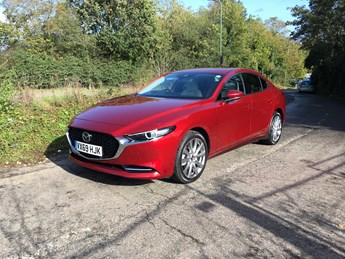
|
|
||||||||||||||
Final Report: Two for the price of a 3
By Tony Rock
We switched from grey to red and from hatchback to saloon midway through our test period with the 3 due to Mazda unexpectedly discontinuing the single diesel option, saying there had not been enough demand for the 116hp 1.8-litre engine. As well as making the colour and body style changes, we also moved to the Skyactiv-X petrol engine when the old vehicle was swapped for its replacement.
In some ways, the switch proved a little disappointing. For example, the diesel engine was impressive: With a test average of around 58.0mpg it not only matched but exceeded its 56.5mpg official combined fuel economy figure on a diet of the occasional long-distance motorway drives mixed with regular rush-hour dual-carriageway and town centre work. The engine's refinement was good too.
And then there were the striking looks. From a front three-quarter angle, the rounded shape of the roofline combined with the smooth sides and lack of fussy detailing gave the family hatchback a clean, futuristic, almost spaceship-like appearance.
But the replacement wasn't all bad. After all, we much preferred the new car's red to the original vehicle's boring grey. And while the saloon isn't as strikingly styled as the 3 hatch, in our opinion it still is a very handsome car. It also came with the optional cream upholstery. It's arguable whether or not it was an improvement on the black trim of the hatch, but some who travelled in the hatch found the darkness slightly claustrophobic, while the cream interior offers a lighter and airier feel (although there's a question mark over its practical merits).
Perhaps, also, we shouldn't have felt so forlorn about the departing diesel, especially when Mazda describes the Skyactiv-X petrol engine as a non-turbo with a diesel-style compression ignition system, with an added mild hybrid boost, which the manufacturer says is designed to offer the best of both traditional petrol and diesel engines, including high efficiency. And at 180hp, the 2.0-litre engine was also more powerful than the diesel, meaning concerns about a lack of low-down torque compared with a turbo-petrol or diesel motor were never really an issue. Granted, it was necessary to shift down a gear a bit more on motorways than in the diesel 3, and one particular steep uphill dual-carriageway required some serious throttle work, but that aside, it wasn't a problem: normal driving around town or on flat A-roads was managed in an unflustered manner. Our final fuel economy figure of 40.8mpg could have been better, compared with the 50.4mpg official WLTP, but that was on a diet much like the diesel's initially, and latterly included countryside road runs of 10 miles or fewer.
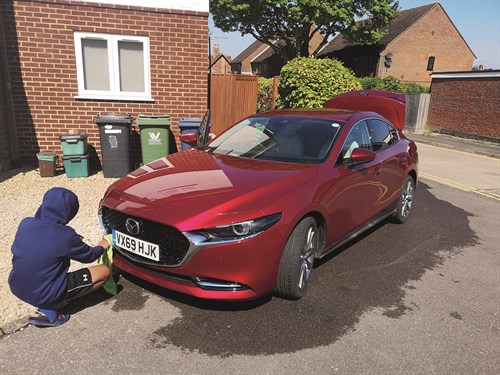
The cabin was a nice place to spend time, being a combination of attractive swooping lines and good-quality materials, while another advantage of the switch to a saloon was acquiring a bigger boot, which at 444 litres was almost 100 more than the hatch. Talking of the boot, one thing we had to watch out for was inadvertently popping the lid open when using the key fob to unlock the car, which happened fairly frequently due to the two buttons being close to each other.
There was a whole list of tech we enjoyed during our test period with the car, such as the head-up display. As well as the car's speed, this projected other useful info - speed limit, cruise control settings, alerts from the various onboard safety systems, and satnav directions, for example - onto the windscreen. And the night-time effect of the gentle play of light and shadow cast on, for example, trees lining the side of a road as the adaptive LED headlight system worked constantly to maximise the illumination available for the driver was fascinating to see - once I'd stopped worrying that the lights weren't working as they should and were instead blinding the drivers in approaching vehicles.
Blind spot monitoring (a light illuminating in the wing mirrors when a vehicle enters the Mazda's blind spot) with an accompanying sharp, audible alert if you indicate in the direction of an upcoming vehicle, is a useful instrument in a packed toolbox of safety technology. There's also lane departure warning, which lets you know - visually on the dashboard's multi-information display, audibly, and physically by vibrating the steering wheel - that you're leaving your lane without indicating. It comes in addition to lane-keep assist, which is when the car provides steering assistance to keep you on track in similar circumstances. I found the system over-sensitive at times. I also thought the adaptive cruise control was a little disconcerting in heavier traffic, although it, like the lane-departure warning and much of the other tech the car offers, can be turned off if you want.
Finally, I should mention that when the Mazda first arrived months ago we made full use of the heated steering wheel and heated seats, although it feels strange to highlight that, given that as I write this the weather is being particularly gorgeous. It's not just the weather's that has changed since the Mazda3 turned up - life, too, has been transformed due to Covid-19, and a car that was busy taking children to school and their various after-school activities as well as weekend family trips has remained largely parked up on the driveway in recent times. As much as I used to moan about the amount of driving required to maintain the kids' busy life style, I have missed getting behind the wheel, and will miss the Mazda3.
9th Report: Putting the Focus on our Mazda3
By Tony Rock
With the Ford Focus topping the sales charts in its class as of February this year, according to the Society of Motor Manufacturers and Traders (and second only to the Ford Fiesta in the overall top 10 of vehicle registrations that month), as well as being the Best Lower Medium model in the 2019 Business Car Awards, it seems the obvious yardstick by which to measure our long-term Mazda3.
We pitted the 3 in saloon 2.0 180 GT Sport guise against the 1.5L Ecoboost ST-Line of the Focus hatch in a Top Trumps-style (the card game, not the family) head-to-head to see how the two petrol-powered models compare in the light of the cold, hard stats.
Let's start with price. The Mazda3's P11D is £24,070, while the Focus comes in at £23,670, so it is first round to the Ford by a few hundred pounds.
However, according to Comcar, a Focus owner will pay more in company car tax, with someone on the 20% rate having to find £1,231 compared with £1,107 for the Mazda for 2020/21.
The 3 fights back, though, on CO2 emissions, emitting 102g/km versus the Ford's 112g/km when using the NEDC measure, or 127g/km versus 134g/km with the WLTP method. Sticking with WLTP, the Mazda beats the Ford for fuel economy too, returning 52.3mpg on the combined cycle against its rival's 46.3mpg.
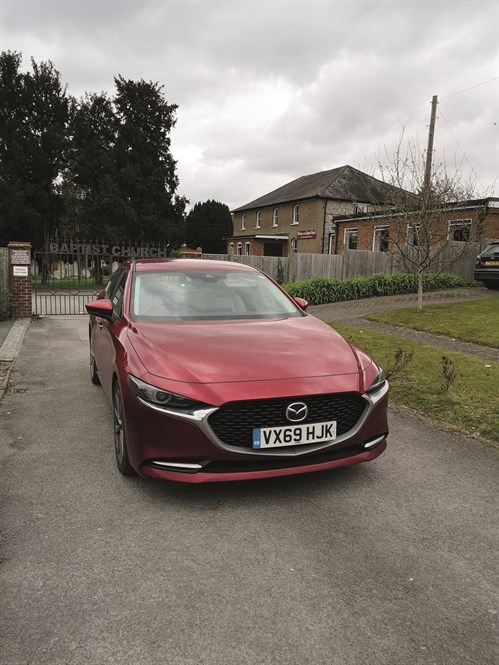 If it is power you want, then the 3 saloon is the car for you, with its 1,998cc engine producing 180hp, while the Focus's smaller 1,498cc engine delivers 150hp. In terms of performance, for the Mazda this translates into a maximum speed of 134mph and a 0-62mph sprint time of 8.2 seconds. This compares with a top speed of 130mph for the Focus and 8.8 seconds for 0-62mph.
If it is power you want, then the 3 saloon is the car for you, with its 1,998cc engine producing 180hp, while the Focus's smaller 1,498cc engine delivers 150hp. In terms of performance, for the Mazda this translates into a maximum speed of 134mph and a 0-62mph sprint time of 8.2 seconds. This compares with a top speed of 130mph for the Focus and 8.8 seconds for 0-62mph.
You can't split the two vehicles for safety, with both getting a five-star NCAP safety rating, or warranties (three years, 60,000 miles in each case), and you can barely separate them either for boot capacity, with the Ford providing 443 litres of room and the Mazda3 going one better with 444 litres.
So on the face of it, it appears that the Mazda gets the better of the Ford in most of the categories we have chosen, although, of course, there are lots of other figures we could have used for comparison purposes (residual values, for instance), and plenty of other rivals out there to choose from, like the Honda Civic, Volkswagen Golf and Seat Leon. There are also all the other (not necessarily measurable) factors to consider when choosing a vehicle that we haven't covered here, such as comfort, equipment, reliability, etc.
However, despite ours being a less-than-comprehensive comparison, it is nevertheless instructive and enables the Mazda3 to be seen as a worthy contender to its market-leading rival.
Like many of you during this novel coronavirus pandemic, I have not been out on the road recently. During that time, I thought about putting the Mazda (and me) forward to transport supplies and equipment for the NHS Volunteer Responders programme.
However, that avenue is yet to be explored because, due to the fantastic response to the government's request for help (750,000 applications when I last checked), the website was shut temporarily to cope with the backlog during my time in quarantine, and at the time of writing was yet to re-open.
8th Report: Mazda on the M1
By Tony Rock
I took the Mazda3 on a two-and-a-half-hour run to Sheffield over one recent weekend due to one of the kids being involved in a sporting event. A large part of the journey both there and back involved the use of the M1 motorway, which meant a chance to interact with several of the car's driver safety systems.
First up is the blind-spot monitoring. It works via a light that illuminates in the wing mirror when a vehicle enters the Mazda's blind spot on either side. There is also, in this case, the added safety feature of getting a sharp, audible alert if you indicate in the direction of an upcoming vehicle, warning you not to carry out your proposed manoeuvre of changing lane, although in my defence I had noticed the overtaking vehicle, but indicated a little on the early side.
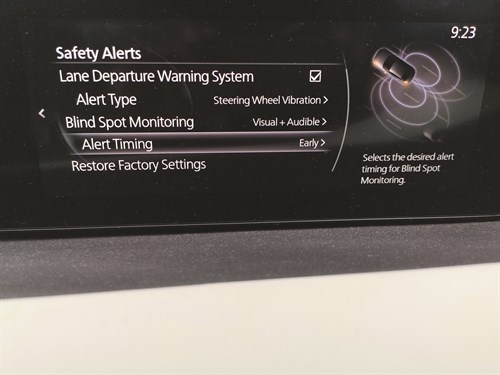 Another piece of technology that prevents unwise lane-changing is lane-departure warning, which lets you know visually on the dashboard's multi-information display that your lane discipline isn't what it should be. It too delivers an audible warning if you (don't quite) cross the line without indicating beforehand, and the steering wheel also vibrates. At times I found it over-sensitive and didn't enjoy the sense of being reprimanded, although that doesn't mean I didn't deserve to be. Fortunately, if you're the type who might find it too irritating, it can be turned off (see image above). One thing to note is that it is different and comes in addition to lane-keep assist, which is when the car provides steering assistance to keep you on track in similar circumstances.
Another piece of technology that prevents unwise lane-changing is lane-departure warning, which lets you know visually on the dashboard's multi-information display that your lane discipline isn't what it should be. It too delivers an audible warning if you (don't quite) cross the line without indicating beforehand, and the steering wheel also vibrates. At times I found it over-sensitive and didn't enjoy the sense of being reprimanded, although that doesn't mean I didn't deserve to be. Fortunately, if you're the type who might find it too irritating, it can be turned off (see image above). One thing to note is that it is different and comes in addition to lane-keep assist, which is when the car provides steering assistance to keep you on track in similar circumstances.
Despite the misgivings expressed in my previous report about adaptive cruise control, I gave the Mazda 3's a go. With previous vehicles I've found the system's braking in particular a little disconcerting in heavier traffic, and that was no different here, so I deactivated it for the length of the 50mph roadworks section on the M1. The distance the technology maintains between you and the vehicle ahead can be adjusted to several points between 50m and 25m, although I found my nerves didn't enjoy the 25m setting.
The Mazda also comes with a distance and speed alert system, "which provides advice for maintaining the appropriate distance between vehicles and notifies the driver of the recommended safe distance to maintain with a vehicle ahead". It, too, proved useful, although I must end by saying that with all the warnings that flash and ping at you while you're driving it must take a little while to distinguish the differences between them, plus there is a risk that in themselves they could be distracting. However, overall you'd be a fool not be in favour of such technological advances because, as is said, it's better to be safe than sorry.
7th Report: Technology you can trust
By Tony Rock
For me, so much of modern technology is about trust. For example, it took me a while to learn to trust cruise control on any car, just as it took me a while to learn to trust adaptive cruise control.
The same with automatic high-beam assist - the first few times I was never sure the full beam would automatically dip when a car approached, and would wait with a finger poised by a lever ready to do the job manually.
Now it is the same with the Mazda3's adaptive LED headlight system. For a while I wasn't convinced it was working, particularly when cars came the other way, and when I thought nothing had happened I would panic and turn the system off, relying on old-fashioned lever pull to activate/deactivate full beam on night-time countryside roads.
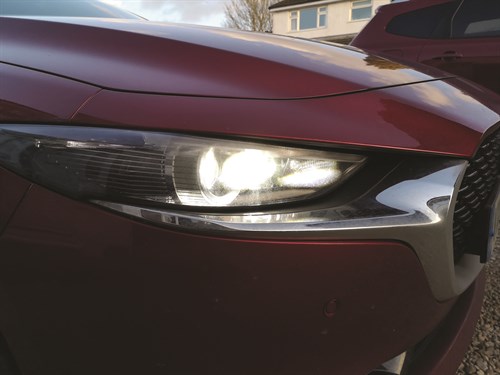
That was because I couldn't see any discernible difference as a vehicle approached - it looked as if my full beam was still on, and a quick glance to the instrument panel to see the blue headlight symbol confirmed that it was.
Then I watched a Youtube video to see the tech in action, and was able to replicate that demonstration (to some extent) locally, leaving me convinced that the system was operating as intended.
So how does the adaptive system work? And what did I see, now that I knew what to look for?
A windscreen-mounted, forward-sensing camera reads the traffic conditions ahead and adjusts the lighting accordingly. Visibility is increased by the use of three technologies: at speeds of around 25mph or over 'glare-free high beam' automatically "dims only the high-beam light shone on the vehicle ahead" to avoid dazzling other drivers in front or approaching in the opposite direction; 'wide-range low beam' "extends the illumination range" at speeds of under about 25mph; and 'highway mode' helps you see further when travelling at speed by shifting the illumination angle upwards.
The effect of all this is a gentle play of light and shadow cast on, for example, trees lining the side of a road as the technology constantly works to maximise the illumination available for the driver. I like it, but it will take a few more weeks of not being flashed by oncoming blinded and angry motorists for it to fully earn my trust.
6th Report: Engine of the future?
By Sean Keywood
It is a few months now since our Mazda3 saloon arrived, so it seems like a good time for an update on its most innovative feature, the Skyactiv-X engine. To recap, this is a non-turbo petrol engine with a diesel-style compression injection system, with an added mild hybrid boost, which Mazda says is designed to offer the best of both traditional petrol and diesel engines, with improved efficiency.
When I first drove the car, my concern was that a lack of low-down torque compared with a turbo petrol or diesel motor would mean needing to mash my right foot into the carpet to make any progress, but from behind the wheel at least this hasn't seemed a major issue. OK, I have to shift down a gear a bit more on motorways than in the (now discontinued) diesel 3 I ran previously, and the odd road such as the steeply uphill dual carriageway out of Maidstone requires some serious throttle work, but most of the time it is a non-issue.
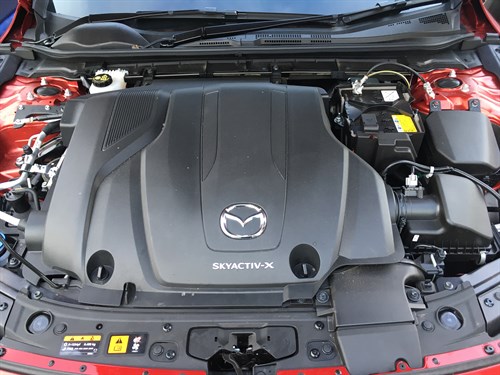
While you do need to work it hard to reap the full performance suggested by the 180hp official output figure, when driving normally around town or on level A-roads the performance is perfectly adequate for unflustered progress, and it feels no different to the typical sort of turbo petrol engine you might find in rivals of a similar size and price - a driver used to one of those wouldn't find it underpowered.
As we have mentioned before, the big advantage of the Skyactiv-X on paper is its low official CO2 emissions figure, which stacks up very well against said petrol rivals and also non-RDE2-compliant diesels. However, the concern was that the price for this would be paid in fuel bills, and while it hasn't felt like I have been ragging the engine unduly, its current test average of 42.4mpg is a bit of a disappointment compared with the 50.4mpg official WLTP figure and the 58mpg I previously achieved in the diesel. In the Skyactiv-X's defence, however, my recent schedule has been very light on long motorway runs, so this has mostly been achieved on rush hour commutes. With the 3 still having a couple of months left to run on its time with us, hopefully it can get a bit closer to the official figure by the time it departs.
5th Report: A wheely good idea
By Sean Keywood
The past few weeks, with the arrival of overnight frosts and winter approaching in earnest, has made me grateful for two things. Firstly, that I am no longer a local newspaper reporter who round about now has to write hundreds of articles with 'festive fun' in them. And secondly, that our Mazda3 has a heated steering wheel.
I have never run a car with this feature before, and now that the weather merits its use I think it can be filed alongside Toy Story 3 in the category of 'things I didn't know I needed until they arrived'. Having walked the couple of minutes it takes to get to where I park in the morning, and then potentially had to spend time de-icing the windows, it becomes the height of luxury to place my cold hands on the also chilly steering wheel, then think 'oh yeah!' and press the heating button.
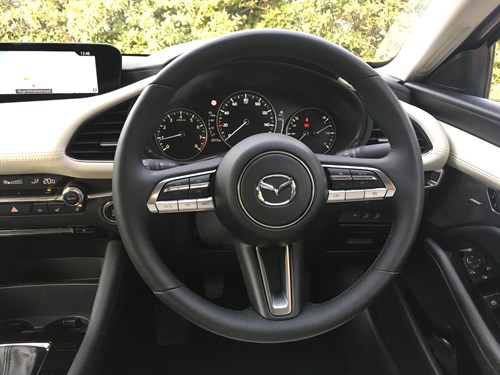
The system doesn't make the wheel furnace-hot, just comfortably warm, like wearing gloves, and that is exactly what is needed. Along with the car's heated seats (both are standard with GT Sport spec), it means the discomfort of December commuting is greatly reduced.
Another feature of our 3 I didn't expect to appreciate as much as I do is its boot. Saloons have been out of favour in the lower-medium segment for some time now, with hatchbacks having a seemingly obvious practicality advantage, but a couple of recent trips to the airport have made me see its benefits. There is the space - 444 litres, nearly 100 more than the hatch, and still extendable further by folding the seats down - and perhaps less obviously the security. When having to leave luggage in the car for days in an airport car park, it is extremely reassuring to know it is locked away in a separate boot that thieves can't simply smash their way into through a window.
It is just a little bit of peace of mind that takes an extra bit of stress out of travelling.
4th Report: Battery blunder
By Sean Keywood
I didn't have the best of starts with our Mazda3 saloon, for reasons entirely of my own making. Having got used to relying on automatic headlights, I hadn't realised that the delivery driver had left the switch in the manual 'on' position, and promptly drained the battery over a weekend, having somehow failed to twig why the car was chiming at me as I got out of it (and missed the warning message on the dash).
The incident did, however, lead to two noteworthy observations. The first, a negative, is how much of a literal pain it is to open the car when the keyless entry system isn't working, due in this case to the flat battery. A manual key is hidden inside the fob, but it lacks a proper handle, meaning you have to awkwardly grip the metal shaft to use it. I initially failed to find the slot it goes into, possibly as it was pouring with rain at the time, but even once I was informed it was hidden under the driver's door handle it was a fiddly and frankly painful process to force the key in and turn in. Having unlocked the car and confirmed my headlight mistake, I then couldn't get the key to turn the other way to lock it again (although in hindsight a thief would hardly have got very far with a flat battery).
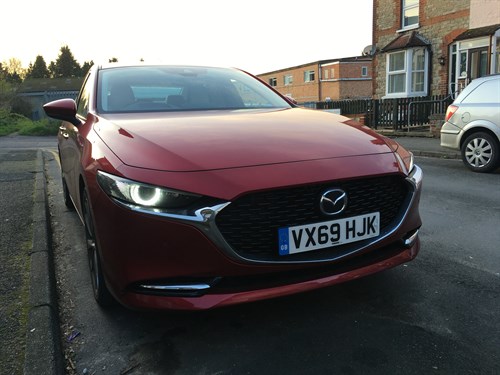
The second, more positive observation is that when the breakdown van turned up, its driver proclaimed himself very impressed with the appearance of the car itself, and this is an opinion that I have come to share. I said when I reviewed the saloon last month that it wasn't as strikingly styled as the 3 hatch, and I still think that is true, but away from a launch event surrounded by hatches and on normal roads among regular traffic, I have decided it is a very handsome car in its own right. It also stands out from the hatch I ran previously thanks to cream (officially stone) upholstery, a £200 option. Personally, I am not sure this is better than the black trim the hatch had, but some who rode in the hatch found it slightly claustrophobic, and the cream does give the interior a much more light and airy feel. Many will no doubt welcome this, although I can't imagine families with children would find it very practical.
3rd Report: Into the red
By Sean Keywood
Regular readers may notice that for this month's update, our Mazda3 appears to have changed colour and grown a bigger boot. Well, rest assured this is not linked to my previous complaints about grey cars (although I do prefer the new red). The reason for the change is that Mazda unexpectedly discontinued the diesel version of the 3, the hatchback version of which we were running previously, saying there had not been enough demand for it from customers. Therefore, we have switched to running the new Skyactiv-X petrol engine in the also-new 3 saloon.
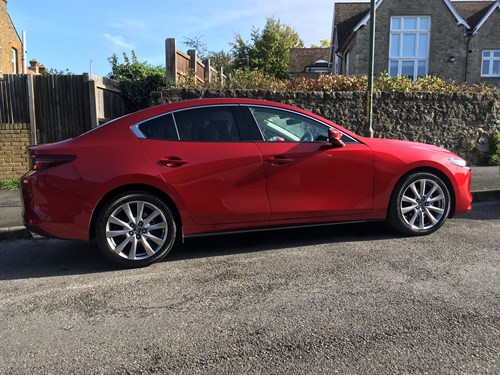
You can read more about this bodystyle and powertrain combo in our recent review, and I am particularly interested to see how this innovative engine performs during day-to-day use. However, I think it is worth noting here how impressive I found the diesel engine to be, and why I think it is a shame it didn't attract more demand from buyers. For starters, with a test average of 58mpg it managed to not only match but exceed its 56.5mpg official combined fuel economy figure, which despite the new WLTP testing cycle supposedly making this easier than under the old NEDC regime, is still impressive. It is not like I was on economy runs either - the figure was achieved from occasional long-distance motorway drives mixed with my regular rush hour dual carriageway and town centre commute. The fact that such a strong real-world economy figure is possible without a great deal of effort shows exactly why we at Business Car believe diesel is still the best option for so many fleet applications.
Not only that, but the engine's refinement was good too. Having tested a couple of relatively noisy diesel rivals, it was a revelation to step back into the Mazda and find that with the radio on the engine was close to inaudible, even when accelerating down a slip road to join a motorway. Together with the economy it made the diesel engine an impressive package. Mazda reckons the Skyactiv-X engine has diesel-like characteristics; the upcoming back-to-back comparison will be an ideal test of those claims.
2nd Report: Keep your head up
By Sean Keywood
When experts debate why UK road death figures are broadly static, despite improvements in crash protection and the arrival of safety systems such as autonomous emergency braking, the issue of driver distraction often comes up. The concern is whether the proliferation of both in-car screens and smartphones is making drivers take their eyes off the road more. Happily, this is something our Mazda3 addresses, thanks to its head-up display, or Active Driving Display in Mazda parlance, which projects key information onto the windscreen directly in front of the driver. At first I was worried this might be annoying, or a distraction in itself, but in fact a few weeks into our test it's one of my favourite features of the car (for those who don't agree, it can be switched off).
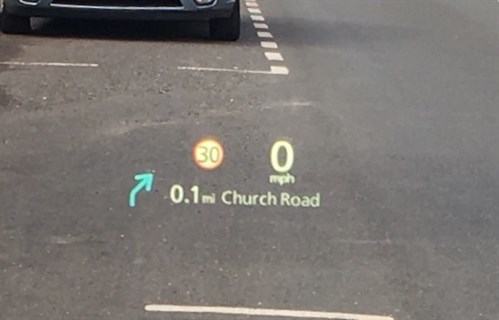
Among the info displayed is the car's speed - which means I don't have to look down at the instrument panel when negotiating speed limit changes such as the ones on smart motorways - the current speed limit, cruise control settings, and alerts from the various on-board safety systems, such as blind spot monitoring and collision warnings. Most usefully of all for me, it also displays sat-nav instructions. As someone who gets annoyed by the voice function in sat-navs and always has it off, I run the risk of missing turnings in most cars if I don't remember to look down at the screen, but having the next instruction displayed in my eyeline makes this next to impossible.
But the head-up display doesn't stand alone - it's part of a highly impressive overall infotainment package. The 8.8in central screen features sharp graphics and an easy-to-navigate interface, and it's operated by a rotary controller in the style of BMW's iDrive set-up. This works very well and is easy to get used to, meaning it wasn't long into our time with the 3 before I could flick between, for instance, the sat-nav map and the radio screen without having to take my eyes off the road. The only slight annoyance is that the screen isn't a touchscreen - fine when driving, but it means addresses have to be entered into the sat-nav letter-by-letter via the rotary controller, which is a bit time consuming.
1st Report: It's a shame about grey
By Sean Keywood
When I first saw pictures of the new Mazda3, I thought it was one of the most striking-looking new cars to be launched this year. From a front three-quarter angle in particular, something about the perfectly rounded shape of the roofline, combined with the smooth sides and lack of fussy detailing, seemed to give it a clean, futuristic, almost spaceship-like appearance, which isn't something I would normally expect to be saying about a family hatchback. Therefore, I was excited to find that I would be running one on the Business Car fleet for the next six months.
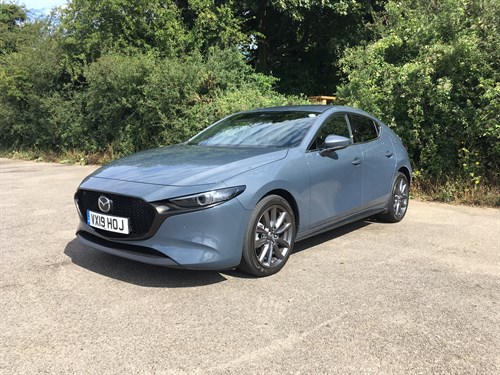
However, there was an initial disappointment - the colour. Now, I am well aware that, according the SMMT, grey is currently the most popular shade for new cars in the UK, and if you are reading this magazine you will know a major reason why - restrained colour choices typically mean more solid residual values. But ask a child what they think of grey cars and they will say they are boring, and they are dead right - I would much rather have had a red one like in the first pictures when the car was launched. Still, it does represent an ideal test of the Mazda's looks - can it stand out for me despite the colour? The good news is that, on initial impressions, it just about does, with some well-deployed black detailing lending a hand. I'll be interested to see whether my opinion shifts one way or the other as I get used to it day-to-day.
The other thing to note about our 3's grey paint is it's actually the only optional extra the car comes with - in fact metallic paint is the only cost option Mazda is offering. Everything else with the 3 is standard kit, and with the high-end GT Sport equipment grade on our car - only one step down from the top of the range, - there is quite a lot of it. From the spec sheet, initial stand-out features include a head-up display, which is actually standard throughout the range (it will be interesting to see if this proves useful or a gimmick). Our car also has adaptive cruise control, which I am hoping will be a stress-saver on busy motorways. There is also a feature I have not had on a car before, a heated steering wheel - though obviously it will be a few months before I am able to properly assess its usefulness. Otherwise, first impressions of the interior are that it lives up to the promise of the exterior styling - it is a nice place to sit, with attractive swooping lines, good-quality materials on the dash and switchgear, leather seats, and a raised central armrest/storage bin arrangement that integrates with the centre console in a way that is reminiscent of the German premium brands, and on initial impressions doesn't suffer for the comparison.
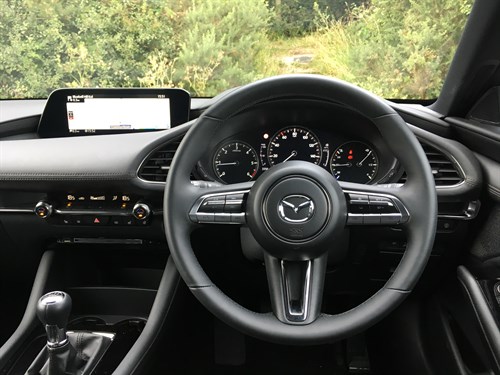
Under the bonnet? Well, while the decline in diesel car registrations shows no sign of abating, we still think they make sense for high-mileage company car drivers, so our 3 has the single diesel option Mazda is offering, a 1.8-litre with 116hp. It is not the engine in the range that Mazda is making the most fuss about, however; instead, the firm is hyping the new Skyactiv-X, a 2.0-litre, 180hp petrol set to arrive in showrooms in October. As well as being more powerful than the diesel, the Skyactiv-X will also, thanks to slightly lower CO2 emissions and the BIK surcharge on diesel cars, sit five company car tax bands lower. Clearly, then, this will be very tempting for drivers, but fleet managers will likely be more impressed by the official fuel economy advantage the diesel still holds. My time with our 3 will hopefully shed some light on whether this is an argument managers can reasonably hope to win.










